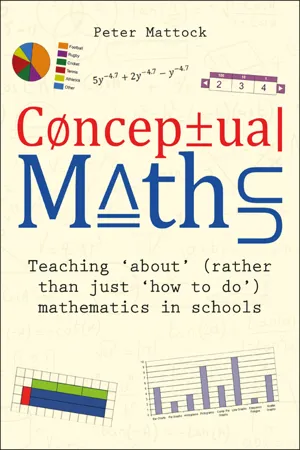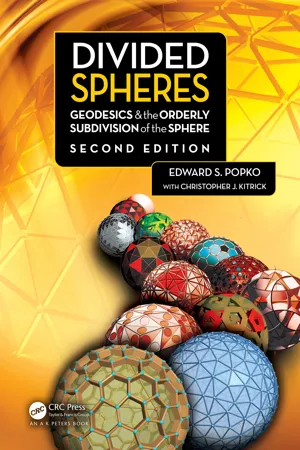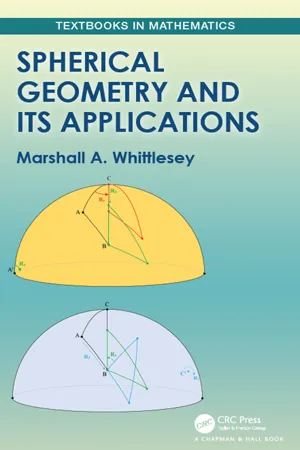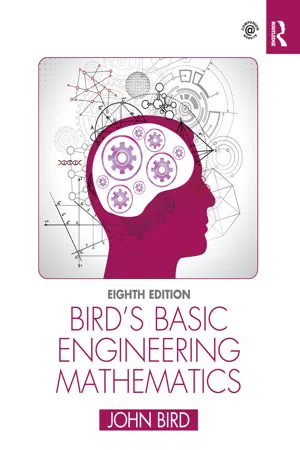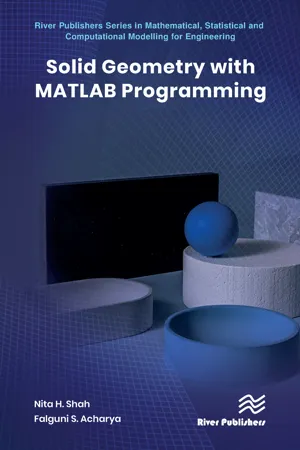Mathematics
Volume of Sphere
The volume of a sphere is the measure of the space enclosed by the sphere. It is calculated using the formula V = (4/3)πr³, where V represents the volume and r is the radius of the sphere. This formula allows for the determination of the amount of space occupied by a sphere in three-dimensional space.
Written by Perlego with AI-assistance
Related key terms
6 Key excerpts on "Volume of Sphere"
- eBook - ePub
Conceptual Maths
Teaching 'about' (rather than just 'how to do') mathematics in schools
- Peter Mattock(Author)
- 2023(Publication Date)
- Crown House Publishing(Publisher)
.Similarly, the volume of a cone can be found by treating it as analogous to a pyramid, being a third of the volume of the containing cylinder. However, it is more difficult to visualise this than with a square or rectangular pyramid (where we can show pyramids attached to the side of the prism as well as the base); however, there are nice video demonstrations that involve filling a cone-shaped container with water and pouring it into a cylindrical container with the same base circle (as demonstrated in the video linked below27 ).This leads to the volume of the cone formula being equal to πr2 h, or alternatively . One thing that pupils need to be clear on here is the use of the vertical height when calculating the volume of a cone, which is in contrast to the use of the slant height when calculating the curved surface area. Offering pupils opportunities to work with both of these is important to make sure pupils use the correct lengths in the correct situations.When it comes to finding the volume of the sphere, again typically calculus would be used to derive the formula; however, there are similar demonstrations to the one above: particularly showing that the sphere of radius r (and therefore diameter 2r) can be filled with a cone with height 2r (and therefore volume of πr3 ) twice over leading to the conclusion that the volume of the sphere can be calculated by πr3 .28 There is also a derivation of the formula that doesn’t require calculus, but does require Pythagoras’ theorem and a reasonable amount of geometric knowledge and insight. The proof rests around demonstrating that when a hemisphere is placed inside a cylinder with the same height and radius (as per the next image) it is possible to show that the space inside the cylinder outside of the hemisphere is equal to the space taken up by a cone with the same radius and height as the cylinder.389 - eBook - ePub
Divided Spheres
Geodesics and the Orderly Subdivision of the Sphere
- Edward S. Popko, Christopher J. Kitrick(Authors)
- 2021(Publication Date)
- A K Peters/CRC Press(Publisher)
1 Divided SpheresWe owe the word sphere to the Greeks; sphaira means ball or globe. The Greeks saw the sphere as the purest expression of form, equal in all ways, and placed it at the pinnacle of their mathematics. Today, the sphere remains a focus of astronomers, mathematicians, artisans, and engineers because it is one of nature's most recurring forms, and it's one of man's most useful.The sphere, so simple and yet so complex, is a paradox. A featureless, spinning sphere does not even appear to be rotating; all views remain the same. There is no top, front, or side view. All views look the same. The Dutch artist M. C. Escher (1898–1972) ably illustrated this truth in his 1935 lithograph where the artist holds a reflective sphere in his hand as he sits in his Rome studio.1 It's easy to see that even if Escher were to rotate the sphere, the reflected image would not change. His centered eyes could never look elsewhere; the view of the artist and his studio would be unchanging. His sphere has no orientation, only a position in space.The sphere is a surface and easy to define with the simplest of equations, yet this surface is difficult to manage.2 A sphere is a closed surface with every location on its surface equidistant from an infinitely small center point. A mathematician might go one step further and say the sphere is an unbounded surface with no singularities, which means there are no places where it cannot be defined. There are no exceptions.1 1935 Lithograph, M. C. Escher's “Hand with Reflecting Sphere” © 2009 The M.C. Escher Company Holland. All rights reserved.2 The equation of a sphere is very simple. For a sphere whose three-dimensional Cartesian origin is (0, 0, 0), a point on the sphere must satisfy the equationr =.x 2+y 2+z 2The sphere is unusual, it has no edges, and it isundevelopable. By undevelopable, we mean that you cannot flatten it out onto a two-dimensional plane without stretching, tearing, squeezing, or otherwise distorting it.3 - eBook - ePub
- Marshall Whittlesey(Author)
- 2019(Publication Date)
- Chapman and Hall/CRC(Publisher)
Chapter 2The sphere in space
We begin our study of spherical geometry by noting two different ways of presenting the subject, both of which we consider in this book.We may first consider a sphere the way most people understand it: as a round object that lives in three-dimensional space. By doing so, we may use the tools of three-dimensional geometry, trigonometry, and vectors to learn about the sphere. This we will call an extrinsic approach to spherical geometry. An understanding of it is particularly important in applications. On the other hand, we may study spherical geometry via the intrinsic properties of the sphere — that is, properties of the sphere that can be thought of without reference to the larger three-dimensional space in which a sphere sits. It will be our main goal to do this in Chapter 3 .We begin by looking at the extrinsic properties of the sphere in this chapter. As we do so, it will be important to understand how to see these properties as intrinsic, and hence motivate the axiom system that we set up in Chapter 3 .5 Great circles
Definition 5.1 Let O be a point in space and r a positive real number. The sphere with center O and radius r is the set of all points in space which lie at distance r from O.The following proposition summarizes the properties of intersections between spheres and planes in space.Proposition 5.2 The intersection between a sphere and a plane in space is a circle, a point, or the empty set.In Figure 2.1 we may see these possibilities geometrically by considering the line in space through the center O of the sphere perpendicular to the plane at point P. We distinguish four cases: P is outside the sphere, on the sphere, interior to the sphere but different from O, or equal to O. In the first case, every point in the plane is outside the sphere because P = P1 is the closest point on the plane to O — hence every point on the plane is at a greater distance from O than the radius. If P = P2 is on the sphere, then the plane is tangent to the sphere, hence meets it in a single point. In the case of P = O, the intersection of the sphere with the plane is the set of all points in the plane at a fixed distance from O. This is a circle. Lastly, suppose P = P3 is inside the sphere, but different from O. Then let X be any point on the intersection of the plane and the sphere, let r be the radius of the sphere, and let d be the distance between P3 and O. Then ΔOP3 X has a right angle at P3 , so the length ofmust be¯P 3X. Thus the points on both the plane and sphere all lie at the same distance from P3 , so lie on a circle. To be complete, we must show that all points in the plane at distancer 2−d 2from P3 are also on the sphere; this is left as an exercise. So the intersection of the plane and the sphere is a circle of radiusr 2−d 2r 2−d 2 - eBook - ePub
- John Bird(Author)
- 2021(Publication Date)
- Routledge(Publisher)
Chapter 28Volumes and surface areas of common solids
Why it is important to understand: Volumes and surface areas of common solidsThere are many practical applications where volumes and surface areas of common solids are required. Examples include determining capacities of oil, water, petrol and fish tanks, ventilation shafts and cooling towers, determining volumes of blocks of metal, ball-bearings, boilers and buoys, and calculating the cubic metres of concrete needed for a path. Finding the surface areas of loudspeaker diaphragms and lampshades provide further practical examples. Understanding these calculations is essential for the many practical applications in engineering, construction, architecture and science.At the end of this chapter you should be able to:- state the SI unit of volume
- calculate the volumes and surface areas of cuboids, cylinders, prisms, pyramids, cones and spheres
- calculate volumes and surface areas of frusta of pyramids and cones
- appreciate that volumes of similar bodies are proportional to the cubes of the corresponding linear dimensions
28.1 Introduction
The volume of any solid is a measure of the space occupied by the solid. Volume is measured in cubic units such asandmm 3,cm 3m 3.This chapter deals with finding volumes of common solids; in engineering it is often important to be able to calculate volume or capacity to estimate, say, the amount of liquid, such as water, oil or petrol, in different shaped containers.A prism is a solid with a constant cross-section and with two ends parallel. The shape of the end is used to describe the prism. For example, there are rectangular prisms (called cuboids), triangular prisms and circular prisms (called cylinders).On completing this chapter you will be able to calculate the volumes and surface areas of rectangular and other prisms, cylinders, pyramids, cones and spheres, together with frusta of pyramids and cones. Volumes of similar shapes are also considered. - eBook - ePub
- John Bird(Author)
- 2019(Publication Date)
- Routledge(Publisher)
Chapter 14 Volumes of common solidsWhy it is important to understand: Volumes of common solidsThere are many practical applications where volumes and surface areas of common solids are required. Examples include determining capacities of oil, water, petrol and fish tanks, ventilation shafts and cooling towers, determining volumes of blocks of metal, ball-bearings, boilers and buoys, and calculating the cubic metres of concrete needed for a path. Finding the surface areas of loudspeaker diaphragms and lampshades provide further practical examples. Understanding these calculations is essential for the many practical applications in engineering, construction, architecture and science.At the end of this chapter, you should be able to:- state the SI unit of volume
- calculate the volumes and surface areas of cuboids, cylinders, prisms, pyramids, cones and spheres
- appreciate that volumes of similar bodies are proportional to the cubes of the corresponding linear dimensions
14.1 Introduction
The volume of any solid is a measure of the space occupied by the solid. Volume is measured in cubic units such as mm3 , cm3 and m3 .This chapter deals with finding volumes of common solids; in engineering it is often important to be able to calculate volume or capacity, to estimate, say, the amount of liquid, such as water, oil or petrol, in differently shaped containers.A prism is a solid with a constant cross-section and with two ends parallel. The shape of the end is used to describe the prism. For example, there are rectangular prisms (called cuboids), triangular prisms and circular prisms (called cylinders).On completing this chapter you will be able to calculate the volumes and surface areas of rectangular and other prisms, cylinders, pyramids, cones and spheres. Volumes of similar shapes are also considered.14.2 Calculating volumes and surface areas of common solids
Science and Mathematics for Engineering. 978-0-367-20475-4, © John Bird. Published by Taylor & Francis. All rights reserved.14.2.1 Cuboid or rectangular prism
- eBook - ePub
- Nita H. Shah, Falguni S. Acharya(Authors)
- 2023(Publication Date)
- River Publishers(Publisher)
3 Sphere 3.1 Definition The sphere is a locus of a point that moves so that its distance from a fixed point always remains constant. The fixed point is called the center of the sphere and the constant distance is called the radius of the sphere. 3.2 Equation of Sphere in Vector Form Consider a sphere S with center C and radius ‘ a ’. Let P be any point on the sphere. Let c → and r → be the position vectors of C and P respectively with respect to O; the origin of reference. ∴ C P → = O P → − O C → ∴ C P → = r → − c → But. radius C P = | C P → | = a. (3.1) ∴ | r → − c → | = a (3.2) ∴ | r → − c → | 2 = a 2 ∴ (r → − c →). (r → − c →) = a 2 ∴ r →. r → − r →. c → − c →. r → + c →. c → = a 2 ∴. | r → | 2 − 2 r →. c → + | c → | 2 = a 2 ∴ | r → | 2 − 2 r →. c → + d = 0 ∴ | r → | 2 − 2 r →. c → = | c → | 2 = a 2 where d = | c → | 2 − a 2 is the equation of sphere in vector form. Case 1): If O lies on the sphere, then OC = OP; i.e., c. = a ⇒ d = 0 The Equation of sphere is | r → | 2 − 2 r →. c → = 0 Case 2): If the center C is at the origin O, then c = 0 and d = − a 2. ∴ Equation of sphere is | r → | 2 − 2 r →. c → = 0 | r → | 2 = a 2 | r → | = a. Equation of sphere in the cartesian form: Consider a sphere S with center C (α, β, γ), and radius ‘ a ’. Let P (x, y, z) be any point on the sphere. Let x → and c → be the position vector of P and C respectively with respect to O; the origin of reference. ∴ r → = x i → + y j → + z k → c → = α i → + β j → + γ k →. The equation in vector form. is | r → − c → | = a. ∴ | (x − α) i → + (y − β) j → + (x − γ) k → | = a ∴ (x − α) 2 + (y − β) 2 + (z − γ) 2 = a 2 which is the equation of sphere S in cartesian form with center C (α, β, γ), and radius ‘ a ’. Remark: When center C is origin. i.e., α = β = γ = 0 then the equation of the sphere is x 2 + y 2 + z 2 = a 2. 3.3 General Equation of the Sphere The general equation of the sphere
Learn about this page
Index pages curate the most relevant extracts from our library of academic textbooks. They’ve been created using an in-house natural language model (NLM), each adding context and meaning to key research topics.
